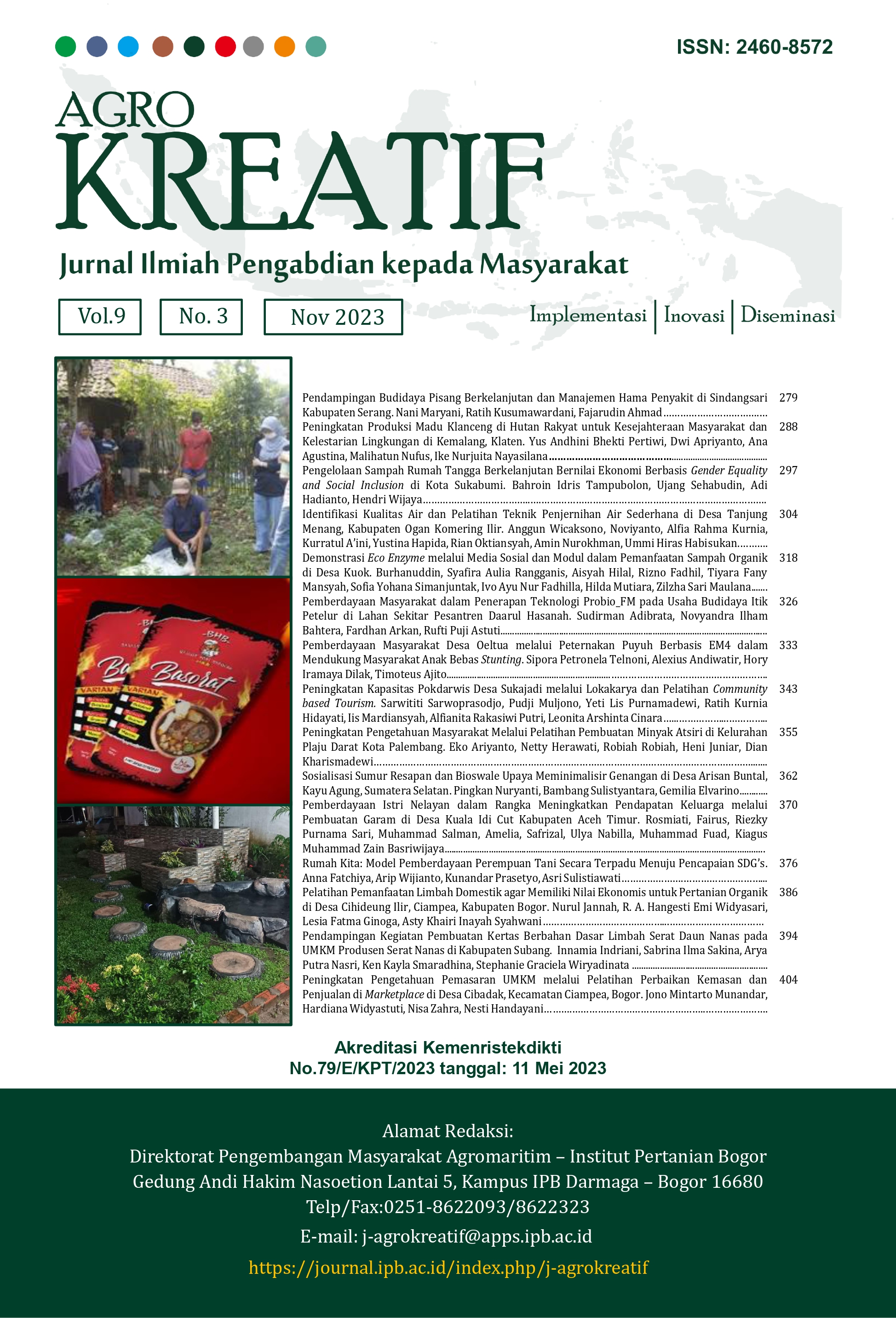Pelatihan Pemanfaatan Limbah Domestik agar Memiliki Nilai Ekonomis untuk Pertanian Organik di Desa Cihideung Ilir, Ciampea, Kabupaten Bogor
Abstract
The high population growth rate in the Cihideung Ilir area is accompanied by a high amount of household waste, known as domestic waste. The existence of domestic waste, if utilized properly, will protect the quality of the environment since it can cause pollution. Therefore, a special effort must be made to utilize this domestic waste to be processed into a product of high economic value. In terms of the conditions, the IPB University Vocational School Lecturer Team was moved to carry out activities with farmers, cadres and residents of Cihideung Ilir Village, Ciampea, Bogor Regency to process domestic waste into Liquid Organic Fertilizer through training on utilization of domestic waste into Liquid Organic Fertilizer (LOF). This community service activity aims to provide knowledge and skills in utilizing domestic (household) waste. Farmers, cadres and local villagers attended the Training activity. The activity started with the presentation of material about LOF, the benefits of LOF and hands-on practice on how to make the Liquid Organic Fertilizer properly. The training materials were delivered directly, followed by interactive questions and answers, as well as an introduction to the tools and equipment that will be used to make organic liquid fertilizer. All the training participants actively and enthusiastically followed the discussions. The training activity for making liquid organic fertilizer is expected to reduce the amount of organic waste generated and to encourage training participants to utilize organic waste in their homes into an organic liquid fertilizer that can provide economic value. The benefits of POC from an environmental point of view can be used as fertilizer for plants in the yard or on agricultural land. From an economic point of view, it can be sold to increase residents' income.
Downloads
References
Febrianna M, Prijono S, Kusumarini N. 2018. Pemanfaatan pupuk organik cair untuk meningkatkan serapan nitrogen serta pertumbuhan dan produksi sawi (Brassica juncea L.) pada tanah berpasir. Jurnal Tanah dan Sumberdaya Lahan. 5(2): 1009‒1018.
Hadisuwito S. 2007. Membuat Pupuk Kompos Cair. Jakarta (ID): Agromedia Pustaka.
Handayani SH, Yunus A, Susilowati A. 2015. Uji Kualitas Pupuk Organik Uji Kualitas Pupuk Organik Cair dari Berbagai Macam Mikroorganisme Lokal (MOL). Jurnal El-Vivo. 3(1): 54‒60.
Juarsah I. 2014. Pemanfaatan Pupuk Organik untuk Pertanian Organik dan Lingkungan Berkelanjutan. Seminar Nasional Pertanian Organik Balai Penelitian Tanah. Bogor (ID). 18–19 Juni.
Karnelasatri, Sinaga K, Tahya CY, Sitinjak D, Purba FJ. 2021. Pengenalan Pupuk Organik Cair dan Sistem Biopori di Kampung Babakan, Tangerang. Agrokreatif: Jurnal Ilmiah Pengabdian kepada Masyarakat. 7(3): 229‒236. https://doi.org/10.29244/agrokreatif.7.3.229-236
Listiyana R. 2016. Pemanfaatan Daun Lamtoro dan Ekstrak Tauge dengan Penambahan Urine Sapi untuk Pembuatan Pupuk Organik Cair. [Skripsi]. Surakarta (ID): Universitas Muhammadiyah Surakarta.
Nur T, Noor, Elma. 2010. Pembuatan pupuk organik cair dari sampah organik rumah tangga dengan penambahan bioaktivator EM4 (Effective Microorganisms). Jurnal Konversi Universitas Lampung. 5 (2): 5–12. https://doi.org/10.20527/k.v5i2.4766
Prasastono N, Rahmawati E, Pradapa SYF. 2017. Effect of price, quality products and brand image Purchase decisions getuk pisang "sari madu" Kediri. Prosiding Seminar Nasional Multi Disiplin Ilmu & Call Papers Universita Stikubank (Sendi_U ke 7). Semarang (ID).
Puspadewi S, Sutari W, Kusumiyati K. 2016. Pengaruh konsentrasi pupuk organik cair (POC) dan dosis pupuk N, P, K terhadap pertumbuhan dan hasil tanaman jagung manis (Zea mays L. var Rugosa Bonaf) kultivar talenta. Kultivasi. 15(3): 208‒2016. https://doi.org/10.24198/kultivasi.v15i3.11764
Zaini H. 2015. Pupuk organik cair dan pupuk organik padat bagi budidaya pisang barangan. Jurnal Handayani. 4(1): 126‒135. https://doi.org/10.24114/jh.v4i1.2865
Copyright (c) 2023 Asty Syahwani

This work is licensed under a Creative Commons Attribution-NonCommercial 4.0 International License.
This work is licensed under a Creative Commons Attribution-NonCommercial 4.0 International License.



















